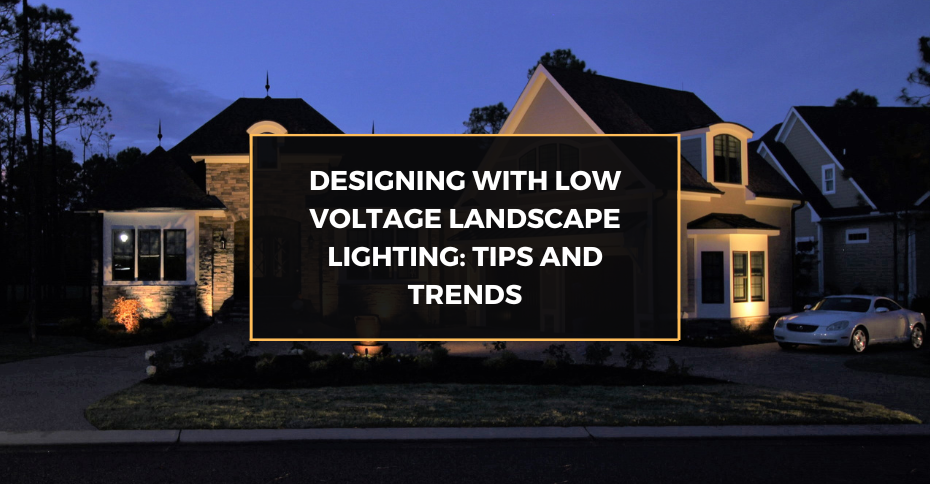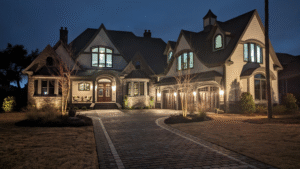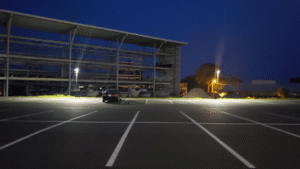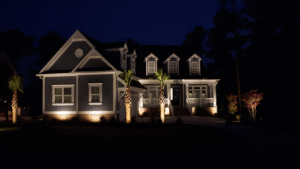Low voltage landscape lighting refers to a system that operates at a reduced voltage of 12 volts, as opposed to the standard 120 volts found in typical household fixtures. This type of lighting is not only safer for outdoor applications, but it’s also more energy-efficient. By converting standard voltage to a lower level through a transformer, low voltage lighting provides a practical yet effective solution for illuminating outdoor spaces. It’s ideal for garden paths, patios, and other outdoor areas, offering a soft, ambient light that enhances the beauty of your outdoor landscaping without overpowering it.
Benefits of Choosing Low Voltage for Outdoor Spaces
Choosing low voltage landscape lighting offers numerous benefits. It’s safer, as the lower voltage reduces the risk of electrical hazards and shocks, especially important in outdoor areas exposed to water and weather elements. It’s also more energy-efficient, leading to lower electricity bills and a reduced carbon footprint. Furthermore, low voltage landscape lighting is known for its versatility and ease of installation, allowing homeowners to experiment with different lighting designs without the need for extensive electrical knowledge.
Design Principles for Low Voltage Landscape Lighting
Designing with low voltage landscape lighting requires a blend of technical knowledge and creative vision. The key lies in understanding how to balance light and shadow to create the desired mood and atmosphere.
Understanding Lighting Placement
Effective placement is crucial in low voltage landscape lighting design. It’s essential to consider both the functional and aesthetic aspects of lighting. Strategic placement can enhance safety, illuminate walkways, and highlight key features of the landscape. For instance, lighting along paths ensures safe navigation, while accent lights can showcase specific garden features or architectural elements.
Balancing Function and Aesthetics
When designing with low voltage landscape lighting, balance is key. The lighting should provide enough illumination for safety and navigation while also creating an inviting and visually appealing outdoor space. It’s about finding the right mix of ambient, task, and accent lighting to create a harmonious effect that enhances the overall appearance of your landscape.
Color Temperature and Its Impact
Color temperature plays a significant role in setting the mood and ambiance of your outdoor space. Low voltage landscape lights come in various color temperatures. Warmer temperatures create a cozy, welcoming atmosphere, while cooler temperatures are ideal for security lighting due to their brighter, more alerting effect.
Latest Trends in Low Voltage Landscape Lighting
The world of low voltage landscape lighting is ever-evolving, with new trends constantly emerging. These trends reflect a blend of technological advancements and changing aesthetic preferences.
Smart Lighting Solutions
Smart technology has revolutionized low voltage landscape lighting. Nowadays, you can control your outdoor lights using a smartphone app or integrate them with home automation systems. This advancement not only adds convenience but also enhances energy efficiency and security, as you can easily adjust lighting based on time, motion sensors, or other criteria.
Popular Styles and Fixtures
Current trends in low voltage landscape lighting also reflect a shift towards more modern and sleek designs. Fixtures with clean lines and minimalistic styles are gaining popularity. Additionally, there is a growing interest in integrating natural materials like stone or wood into fixtures, blending them seamlessly with the outdoor environment.
Practical Tips for DIY Enthusiasts
For DIY enthusiasts, low voltage landscape lighting offers an exciting world of possibilities. With a little bit of planning and some basic electrical knowledge, homeowners can transform their outdoor spaces into beautifully lit havens.
Planning Your Lighting Layout
Planning is a critical step in low voltage landscape lighting. Start by sketching your outdoor area and identify key features you want to highlight. Consider pathways, garden beds, water features, and architectural details. This plan will serve as a guide for selecting appropriate fixtures and determining the placement.
Installation Tips for Homeowners
Installing low voltage landscape lighting is a manageable project for most homeowners. Key tips include: ensuring all fixtures are designed for outdoor use, burying cables at the correct depth to protect them from damage, and using a transformer with enough capacity to handle your total wattage. It’s also important to follow local electrical codes and standards.
Maintenance and Upkeep
Regular maintenance is essential to keep your low voltage landscape lighting in top condition. This includes cleaning lenses and fixtures, checking for exposed or damaged wires, replacing burned-out bulbs, and ensuring that all connections remain secure. Periodic checks will ensure your lighting system remains both functional and beautiful.
Creative Ideas for Different Outdoor Spaces
Creativity is at the heart of low voltage landscape lighting, especially when it comes to different outdoor spaces. Each space, whether it’s a cozy patio, a sprawling garden, or a serene pathway, offers unique opportunities for creative lighting designs.
Lighting Ideas for Patios and Decks
Patios and decks can be transformed into enchanting spaces with low voltage landscape lighting. Consider using step lights for safety, under-rail lights for a subtle glow, and accent lights to highlight architectural features or plants. The key is to create layers of light that invite relaxation and enjoyment of the outdoor space.
Enhancing Garden and Pathways
Low voltage landscape lighting can bring a magical feel to gardens and pathways. Use path lights to gently illuminate walkways, spotlights to showcase specific plants or trees, and floodlights to wash larger areas with light. The aim is to create a landscape that comes alive at night, highlighting its best features.
Focal Points: Accentuating Architectural Features
Accentuating architectural features with low voltage landscape lighting can dramatically enhance the curb appeal of your home. Use well lights for uplighting the facade of your home or architectural columns, spotlights for highlighting unique architectural details, and silhouette lighting to create dramatic backdrops for trees or sculptures.
Choosing the Right Products and Accessories
Selecting the right products and accessories is crucial in the world of low voltage landscape lighting. The market offers a wide range of fixtures, bulbs, transformers, and other accessories, each suited for different needs and preferences.
Selecting Low Voltage Fixtures
Selecting the right low voltage fixtures is essential for achieving the desired effect in your landscape lighting. Factors to consider include the style and material of the fixtures, the type of light they emit, their durability, and compatibility with your existing outdoor environment.
The Role of Transformers and Wiring
Transformers and wiring are critical components of any low voltage lighting system. Choosing the right transformer depends on the total wattage of your lighting, and quality wiring is essential for safety and longevity. It’s important to understand these elements to ensure a reliable and efficient lighting system.
Accessory Options for Enhanced Functionality
Accessories can greatly enhance the functionality of low voltage landscape lighting. Timers, motion sensors, and dimmers add convenience and energy efficiency. Choosing the right accessories can elevate the functionality of your lighting system, making it adaptable to different needs and occasions.
Working with Professionals
Collaborating with professionals in low voltage landscape lighting can elevate a project from good to exceptional. Landscape lighting designers and architects bring a wealth of knowledge and experience, ensuring that every aspect of the lighting design is optimized for both aesthetics and functionality.
When to Consult a Lighting Designer
While DIY installation is possible, there are times when consulting a professional lighting designer is beneficial. Complex landscapes, integration with architectural features, and achieving a specific aesthetic are instances where professional expertise can make a significant difference.
Integrating Lighting with Overall Landscape Design
Integrating low voltage landscape lighting into the overall landscape design is crucial for a harmonious and functional outdoor space. This involves considering the lighting as part of the initial design process, ensuring that it complements the landscaping and architectural elements of the property.
Future of Low Voltage Landscape Lighting
The future of low voltage landscape lighting looks bright and promising. With advancements in technology, growing environmental awareness, and shifting design trends, the possibilities for innovative and sustainable outdoor lighting are expanding.
Predictions and Upcoming Trends
Predictions for the future of low voltage landscape lighting include increased integration with smart home technology, further advancements in energy efficiency, and a continued focus on eco-friendly designs. The trend is towards lighting solutions that are not only beautiful but also intelligent and sustainable.
FAQs
Why is low voltage landscape lighting considered safer for outdoor use?
Due to its lower voltage, it reduces the risk of electrical hazards and shocks, making it safer, especially in outdoor areas exposed to water and weather elements.Can low landscape voltage lighting be effectively used to enhance the aesthetics of small outdoor spaces like balconies?
Absolutely! Low voltage landscape lighting is versatile and can be used in small spaces to create ambiance, highlight decorative elements, or provide functional lighting without overwhelming the area.What are the maintenance requirements for a low voltage landscape lighting system?
Regular maintenance includes cleaning the light fixtures and lenses, checking for and repairing any exposed or damaged wires, replacing burnt-out bulbs, and ensuring all connections are secure. It’s also important to inspect and adjust the placement and angle of the lights as needed.Can low voltage lighting systems be expanded or modified easily after initial installation?
Yes, one of the advantages of low voltage systems is their flexibility. They can be expanded or modified with relative ease.What strategies can be used to creatively light up a garden with diverse flora?
Use a combination of spotlighting for individual plants, soft path lighting for walkways, and broader floodlights for larger areas. Adjusting the lighting angles and intensities can create a dynamic and visually appealing garden space.







